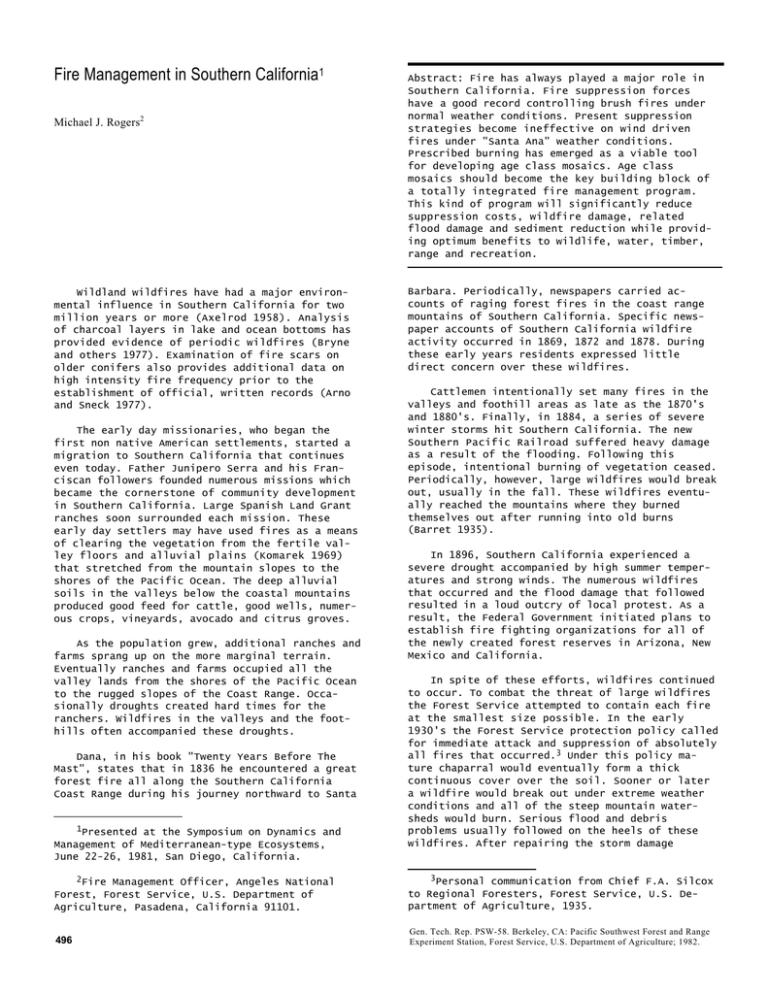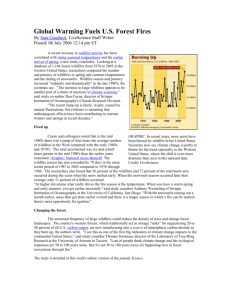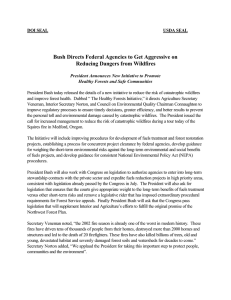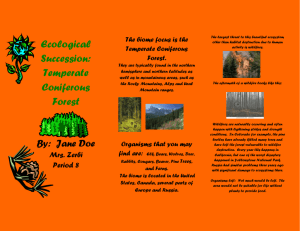Fire Management in Southern California 1
advertisement

Fire Management in Southern California1 Michael J. Rogers2 Wildland wildfires have had a major environmental influence in Southern California for two million years or more (Axelrod 1958). Analysis of charcoal layers in lake and ocean bottoms has provided evidence of periodic wildfires (Bryne and others 1977). Examination of fire scars on older conifers also provides additional data on high intensity fire frequency prior to the establishment of official, written records (Arno and Sneck 1977). The early day missionaries, who began the first non native American settlements, started a migration to Southern California that continues even today. Father Junipero Serra and his Franciscan followers founded numerous missions which became the cornerstone of community development in Southern California. Large Spanish Land Grant ranches soon surrounded each mission. These early day settlers may have used fires as a means of clearing the vegetation from the fertile valley floors and alluvial plains (Komarek 1969) that stretched from the mountain slopes to the shores of the Pacific Ocean. The deep alluvial soils in the valleys below the coastal mountains produced good feed for cattle, good wells, numerous crops, vineyards, avocado and citrus groves. As the population grew, additional ranches and farms sprang up on the more marginal terrain. Eventually ranches and farms occupied all the valley lands from the shores of the Pacific Ocean to the rugged slopes of the Coast Range. Occasionally droughts created hard times for the ranchers. Wildfires in the valleys and the foothills often accompanied these droughts. Dana, in his book "Twenty Years Before The Mast", states that in 1836 he encountered a great forest fire all along the Southern California Coast Range during his journey northward to Santa 1Presented at the Symposium on Dynamics and Management of Mediterranean-type Ecosystems, June 22-26, 1981, San Diego, California. Abstract: Fire has always played a major role in Southern California. Fire suppression forces have a good record controlling brush fires under normal weather conditions. Present suppression strategies become ineffective on wind driven fires under "Santa Ana" weather conditions. Prescribed burning has emerged as a viable tool for developing age class mosaics. Age class mosaics should become the key building block of a totally integrated fire management program. This kind of program will significantly reduce suppression costs, wildfire damage, related flood damage and sediment reduction while providing optimum benefits to wildlife, water, timber, range and recreation. Barbara. Periodically, newspapers carried accounts of raging forest fires in the coast range mountains of Southern California. Specific newspaper accounts of Southern California wildfire activity occurred in 1869, 1872 and 1878. During these early years residents expressed little direct concern over these wildfires. Cattlemen intentionally set many fires in the valleys and foothill areas as late as the 1870's and 1880's. Finally, in 1884, a series of severe winter storms hit Southern California. The new Southern Pacific Railroad suffered heavy damage as a result of the flooding. Following this episode, intentional burning of vegetation ceased. Periodically, however, large wildfires would break out, usually in the fall. These wildfires eventually reached the mountains where they burned themselves out after running into old burns (Barret 1935). In 1896, Southern California experienced a severe drought accompanied by high summer temperatures and strong winds. The numerous wildfires that occurred and the flood damage that followed resulted in a loud outcry of local protest. As a result, the Federal Government initiated plans to establish fire fighting organizations for all of the newly created forest reserves in Arizona, New Mexico and California. In spite of these efforts, wildfires continued to occur. To combat the threat of large wildfires the Forest Service attempted to contain each fire at the smallest size possible. In the early 1930's the Forest Service protection policy called for immediate attack and suppression of absolutely all fires that occurred.3 Under this policy mature chaparral would eventually form a thick continuous cover over the soil. Sooner or later a wildfire would break out under extreme weather conditions and all of the steep mountain watersheds would burn. Serious flood and debris problems usually followed on the heels of these wildfires. After repairing the storm damage 2Fire Management Officer, Angeles National Forest, Forest Service, U.S. Department of Agriculture, Pasadena, California 91101. 3Personal communication from Chief F.A. Silcox to Regional Foresters, Forest Service, U.S. Department of Agriculture, 1935. 496 Gen. Tech. Rep. PSW-58. Berkeley, CA: Pacific Southwest Forest and Range Experiment Station, Forest Service, U.S. Department of Agriculture; 1982. Forest Service personnel would then start all over again, protecting the new brush until it became old and decadent and would again burn under high intensity wildfire conditions. This unsuccessful policy of complete fire exclusion continued until 1978. In addition to implementing a policy of complete wildfire prevention and suppression, the Forest Service took several positive steps in an effort to disarm the explosive potential of the steep brush covered mountain slopes. As fire fighters began to use mechanized equipment to control wildfires, the Southern California Forest Managers began implementing a system of preattack planning. This planning system inventoried all those ridges where mechanized equipment could be worked effectively. The fire fighter now had a way to preplan the placement of bulldozers and other equipment before a wildfire occurred. Unfortunately, wild fires would usually overrun these ridges before the equipment could construct the firebreaks. After repeated failures the Forest Service began requesting and receiving additional funds to preconstruct many of these improvements, especially firebreaks. Wildfires burning under extreme adverse weather conditions quickly overran the preconstructed firebreaks. Heavy winter rains and intense summer thunder showers also caused unacceptable erosion on these firebreaks. Eventually, firebreaks gave way to the wider fuelbreaks. Fuelbreaks support low growing and low volume vegetation which helps to reduce erosion while providing a safe place for fire fighters to make a stand. We learned that even with wide fuelbreak systems supported by roads, heliports and strategically located water systems, under extreme adverse weather conditions (low humidities, low live fuel moistures and strong winds) fire fighters could not effectively isolate a wildfire within the established fuelbreak system. (Pinecrest, Sage, Monte, Crown Valley, Placerita Fires 1979; Mountain Trail 1978; Middle Fire 1977; Mill, Village Fires 1975). However, the fuelbreak system did become highly useful for containing wildfires once the adverse wind conditions subsided. Fuelbreaks will continue to play a key role in reducing the number of acres burned under most high intensity wildfire conditions except under strong Santa Ana wind conditions. However, even under the less extreme weather conditions, fuelbreaks alone will not eliminate the soil damage resulting from the high intensity wildfires that burn between the fuelbreak system (Mountain Trail Fire 1978; Pine Crest Fire 1979; and Stable Fire 1980). Suppression expenditures and related resource damages represent just the tip of the iceberg in terms of wildfire-flood related costs and losses. As an example, the 1975 Mill Fire cost $1.5 MM to suppress and it resulted in some $200,000 in resource damages. The floods and debris which followed this high intensity wildfire in February 1978 caused an additional estimated $75MM in property losses and damages. The majority of the flood and debris damage that occurred throughout Los Angeles County in 1978 could be traced back to recent high intensity wildfires. In spite of all our best prevention, detection, suppression, preattack, firebreak and fuelbreak strategies and the money spent to implement these strategies, we still seem unable to reduce the number of high intensity wildfires that burn under extreme weather conditions and the damages associated with these wildfires. The number of wildfire starts continues to grow each year with 60 wildfires in 1970 to 131 wildfires in 1979.4 For the past thirty years wildfires have burned an average of 18,500 acres on the Angeles National Forest: 1950-1959 16,917 acres; 1960-1969 21,395 acres; 1970-1979 18,511 acres. Most of these large acreage losses have occurred between September and December under high velocity Northeast Santa Ana winds. These wind driven wildfires continue to be the single greatest cause of soil damage and personal property loss in Southern California. Some typical examples of personal property loss follow in Table 1. Unfortunately statistics are not available for the number of structures actually saved under conflagration conditions. Table 1--Dwellings Lost in Conflagration Wildfires, 1970-1980. Fire Name Boulder Mill Sycamore Date 9/70 11/75 7/77 Mandeville Canyon Kanan 10/78 Stable 11/80 Thunder 11/80 Panorama 11/80 10/78 Jurisdiction At Point Of Origin Cleveland National Forest Angeles National Forest Los Padres National Forest Los Angeles City Los Angeles County Los Angeles County Angeles National Forest San Bernardino National Forest Homes Destroyed 383 15 216 20 230 57 26 284 Each wildfire precludes managements option for controlling the timing of quality water yields, creating optimum wildlife habitat conditions, reducing losses of forest soils, providing additional area for grazing, establishing tree plantations and healthy chaparral stands for future dispersed recreation opportunities and for allowing greater use of those portions of forests now restricted by annual fire closures. 4Data on file, USDA Forest Service, Angeles National Forest, Pasadena, California 497 The long, warm, dry summers and mild winters that originally made the Spanish feel at home still continue to draw 200,000 Americans to Southern California each year. Single family residences, apartments and condominiums have long since replaced the ranches, orchards and vineyards established by early day settlers. The unending demand for additional housing and privacy has become so intense that residential developments now compete for the only remaining land base, the steep brush covered privately owned hillsides. Residents of these areas have little understanding or appreciation for the hazards involved with living in the urban wildland interface. Fire Management problems continue to become increasingly complex. Can anything be done to charge or correct what appears to be a growing and totally hopeless situation? Yes, a number of things can be done, however, there are no simple or individual solutions to this complex problem. From the stand point of vegetation management, the fuels that lie between the fuelbreaks must be conscientiously managed and not just protected. Prior to 1975 none of our management strategies suggested managing the carpet of chaparral fuels that lay between the fuelbreaks. Fire modeling (Albini 1976) and personal observations suggest that by managing the age of the fuels the manager can favorably influence fire intensity. The older the fuel, the greater the dead to live fuel ratio and the greater the resulting intensity once ignition occurs (Green 1980). The data in Table 2 illustrates this point very graphically5. Table 2--Brush Fuel Model with Slope at 50 percent, 10 Hour Fuel Stick of 2.0, Wind Speed of 20 Miles Per Hour, on September 4. Age (Years) 10 20 30 40 50 Flame Length (In Feet) 6.36 5.89 19.26 30.09 33.65 Intensity BTU/Sec/Ft 316 267 3,518 9,284 11,838 Size(Acres in 1st Hour) 142 7 102 280 384 With wind, slope and fuel moisture held constant and age of the vegetation the only variable, one can readily see that fire intensity, resistance to control, and acres burned in the first hour begins to increase rapidly beyond twenty years of age. The rapid increase in the dead to live fuel ratio beyond twenty years of age causes these increases. Most of the chaparral species have produced viable seed by their fifteenth year. This data suggests then that somewhere between 15 and 20 years of age, chamise-chaparral vegetation should be converted back to the age of zero, or burned under a 5Van Gelder, Randall, J. Unpublished Firecasting Operators Guide on file at the Fire Lab, Riverside, California. 498 prescription that will remove a large percentage of the smaller sized dead fuels. Prescribed burning can be carried out under a carefully coordinated plan which will result in a mosaic of different age classes. Age class management enables the land manager to have a good deal of control over wildfire intensity and related resource and off site damages. Wildfire suppression should be more effective in the younger, thriftier chaparral fuels. In addition the land manager can now begin to realistically plan for other resource opportunities such as increased grazing, an increase in wildlife habitat diversity, and an increase in quality water yields. Because of the steep slopes and fragile soils, it appears that very few alternative methods of large scale vegetative management other than prescribed burning could be successfully implemented in the Angeles National Forest. The Southern California National Forests have used prescribed burning with a high degree of success as a vegetative management tool since 1977. Based on our experience on the Angeles with both wildfires and prescribed fire I offer the following observations and opinions: FIRE INTENSITY EFFECTS The flood damage that follows wildfires can be directly related to two factors: (1) wildfire intensity and (2) storm intensity. Wildfire intensity increases with the age of the fuels. The combination of older fuels burning under a September-December hot dry Northeast wind conditions creates some of the highest wildfire intensities possible. Not only does an intense fir burning in late summer after a long drying period consume all of the organic matter in the soil, it can destroy the soil structure and create a "water repellent" soil condition. The more intense the fire the greater the change that this "water repellent" soil condition will develop. However, if abundant rain falls, surface water will start flowing down the steep slopes and as these flows gain velocity soil particles become detached and transported. Surface rilling and slumping starts to occur. Major channels scour out down to solid parent material. Tons of debris begin to flow off the slopes and out of the forests into residential areas that border the foothills. All of the main channels in the fire area will carry major debris flows which on the Angeles will usually be contained in debris basins. These debris basins must be cleaned out periodically, at a present day cost of $8.00/cubic yard. During periods of heavy rainfall clean out activities must occur on a daily basis just to keep up with the new debris flowing into the structures. If the daily clean out did not occur hundreds of homes below these structures would be destroyed by flowing debris. Very extensive "water repellent" soil conditions occurred during the 1975 Angeles National Forest Mill Fire, in 56-year-old-fuels. Fortunately only light winter storms occurred during the next two winters. Extensive "water repellent" soils also occurred on the 1977 Middle Fire which burned in 75-year-old-fuels. Heavy winter storms in 1978 produced major debris flows from these two burns which resulted in extensive flood damage and loss of life6. This pattern of severe flooding did not occur however on another wildfire known as the Mountain Trail Fire. The Mountain Trail Fire started on October 23, 1978 under strong Santa Ana wind conditions and burned all of the watershed north of the City of Sierra Madre. In 1978/1979 Southern California experienced another wet winter with expectations for heavy flood damage in the City of Sierra Madre. However, the city did not experience any heavy flooding or debris damage. A review of the fire history records indicated that the Mountain Trail Fire area had not burned since the 1961 Sierra Fire which also occurred under strong Santa Ana wind conditions. During the winter following the Sierra Fire the town of Sierra Madre suffered heavy flooding resulting in extensive damage to numerous homes. Deep rilling, gullying, and slumping had occurred on the mountain slopes sending tons of debris into the city below. Prior to the Sierra Fire, this area had not completely burned since 1911. The Sierra Fire, therefore, burned in 50-year-old-fuel. By contrast, the Mountain Trail Fire burned in 17-yearold-fuel, a relatively thrifty fuel. Although all of the stream channels on the-Mountain Trail Fire produced record amounts of debris, most of this material had accumulated in the ravine and canyon bottoms as dry creep long before the 1978 Mountain Trail Fire. The burning of the thriftier fuels, even under extreme weather conditions, did not result in the extensive "water repellent" soil condition that has developed on other high intensity fall wildfires. During the winters of 1977/78 and 78/79 Ranger District personnel conducted numerous prescribed burns throughout the Angeles National Forest. Many of these burns took place prior to heavy torrential winter rains, the same rains that caused extensive flood damage on areas burned over in the Mill and Middle Fires. We did not observe any rilling or extensive soil movement on these prescribed burn areas. The low intensity prescribed fires, some of them in 60-year-old-fuels, did not create the "water repellent" soil condition that develops when high intensity wildfires burn under extreme weather conditions in older fuel beds. In fact, within two weeks 90 percent of the prescribed burn areas had a cover of grass or herbaceous plants. In addition to carefully prescribed fuel and weather conditions at the time these burns took place, the soils at all burn sites had high moisture contents due to the long and above normal winter-spring rainy season. By contrast, our 6Los Angeles Times feature on a study conducted by California Institute of Technology, Pasadena, California on the Relationship of Wildfire Intensity to Soil Damage; March 5, 1978. damaging wildfires occur in the fall, in older fuel beds, after all the forest fuels have dried out and the living vegetation has become dormant. In April 1980, during a period of 80 mph Northeast winds, some hot material rekindled and escaped outside the burned area perimeter. The resulting wildfire burned in 60-year-old-fuels. Before the winds finally died down the Monroe Fire had consumed 3,000 acres. However, this wildfire occurred in the spring during a time of very high soil moisture. As with all of our prescribed burns new vegetation started to appear within two weeks. By June the burn contained a new carpet of vegetation. Research personnel examined the soils and concurred that little if any "water repellent" soil conditions had developed. The Mountain Trail Fire and the Monroe Fire demonstrate two important concepts. 1. We can influence wildfire intensity by conscientiously managing chaparral fuels in a mosaic of various age classes. The 1978 Mountain Trail Fire showed that less soil damage occurs when younger, thriftier fuels burn then when older fuels burn, even under extreme wildfire conditions. 2. The 1980 Monroe Fire suggests that intense winter/spring fires in the old fuels do not seriously destroy soil structure as do high intensity wildfires in the fall. The high soil moisture content present during Spring Fires appears to play a key role in preventing the creation of "water repellent" soils. We have all observed that vegetative recovery on fall burns occurs very slowly, while on spring burns the reverse situation occurs. PRESCRIBED BURNING AS A MANAGEMENT TOOL Prescribed burning has several distinct advantages over wildfire in that it offers the manager the opportunity to control the size and shape of the burn. Under wildfire conditions no such control exists. If the manager observes the prescribed burn producing higher soil temperatures then desired, the firing pattern can be adjusted accordingly. Again under wildfire conditions no such opportunity exists. With prescribed burning the manager can select the timing and the conditions required to produce an end product consistent with pre established objectives. Again, under wildfire conditions this opportunity does not exist. As we continue to gain experience with prescribed burning, we must develop the capability of burning several thousand acres each day. This concept seemed impossible to even think about several years ago. However, the helitorch now provides us with the capability needed to burn large areas each day. With all of the various constraints we work under such as (1) no burn days because of poor air quality, (2) no burn day because the burn falls out of the prescription 499 on either the low end (humidity and fuel stick too high, no wind, fire won't burn) or the high end (humidity and fuel stick too low, wind too strong, any fire could be too intense), (3) no burn days because a very complex high risk burn will be ignited on an adjoining district and back up forces from neighboring units must be reserved in the case of an escape, (4) insufficient humidity recovery at night which constrains the manager from initiating new prescribed burns until "mop up" of previous burns can be accomplished. This all means that once each critical factor falls into prescription, good soil moisture exists, good humidity recovery occurs in late afternoon and stays through the night, air quality conditions permit prescribed fires and the weather forecast looks favorable for continuation of similar conditions for the next 48 hours or more the manager must move rapidly to accomplish as many acres as possible. For example the goal of 18,000-19,000 acres each year on the Angeles may conceivably take place on 8 to 10 key days where all factors favor planned ignition. These 8 to 10 burn days may be scattered throughout the winter, spring and early summer, between November and early July. Fortunately, the risks will lessen as we eliminate more and more of our 30year-old and older fuels. Hopefully costs can be cut by accomplishing more and more burning without using expensive preconstructed fire lines. We have successfully used humidity recovery on several burns including the Horse Ridge Fuel break in April 1978, and the Drinkwater Fuel Reduction Project in May 1978. In both these cases the humidities rose to the point at about 3:00 pm where we could no longer ignite the fuels. Sustained high humidities through the night nearly extinguished all fire on both projects. Prescribed burn managers monitered the relative humidities using on site hygrothermographs. PREVENTING PRESCRIBED FIRE ESCAPES As previously mentioned the Winter-Spring of 1980 proved to be a totally different kind of year. Humidity recovery above 60 percent rarely occurred for sustained periods. Northeast winds periodically surfaced throughout the winter-spring burning period. On April 11, 1980 a Northeast wind with unpredicted velocities of 80 mph surfaced over the Angeles National Forest. Two prescribed burns initiated originally on April 7 eventually escaped. Both wildfires headed towards heavily populated areas. The Dagger Burn consumed 705 acres and the Monroe Burn consumed approximately 3,000 acres. Fortunately the winds died down before either of these two fires reached the wildland urban interface. Some cautions and considerations for use of prescribed fire in a Mediterranean-type Ecosystem: 1. Under strong wind conditions, the vegetation in a Mediterranean-type Ecosystem will burn at any time of the year. The probability for an intense fast running fire increases dramatically as the 500 fuels exceed 20 years of age. Our most dangerous winds, the strong Northeast winds, can occur during any month of the year. The data in Table 3 comes from a 10 year study (1951-1960) of Santa Ana wind frequency on the Angeles National Forest (Schroeder and others 1964). Table 3--Santa Ana Wind Frequency by Month for the Angeles National Forest. Month January February March April May June July August September October November December Avg. No. Santa Ana Events Each Year 0.7 1.0 1.7 0.8 0.7 0.4 0.2 0.0 1.1 1.9 2.6 1.8 Average Duration (In days) 1.7 1.9 2.5 1.8 1.4 4.5 2.5 0.0 4.4 4.5 5.0 3.7 Avg. No. Santa Ana Days Per Month 1.2 1.9 4.3 1.5 1.0 1.8 .5 0.0 4.8 8.6 12.8 6.6 The probability of high velocity Northeast winds must always be considered when planning to burn. The combination of strong Northeast winds, wildfire and the floods that follow destroy more structures in the wildland urban interface than any other combination of causes. 2. Managers must resist pressures to take risks that they find unacceptable. We have began to build a good solid fuel management program. Admittedly, we have made some mistakes and we have grown from these mistakes. We received criticism that our rate of progress is not fast enough. Today we stand at the crossroads: we can develop a good solid prescribed burning program and continue to enhance our creditability as professional land managers or we can wind up losing this opportunity by becoming overly ambitious and taking some foolish chances. 3. In Southern California, it would be unusual to find good prescription conditions must past July. Therefore, it will remain necessary to attack all those wildfires occurring during the summer and fall with a rapid and aggressive suppression effort. Some people advocate letting wildfires go during the summer wildfire season. They claim these wildfires would develop a natural age class mosaic. Perhaps this concept might have worked prior to the intrusion of residential development into the privately owned wildlands of California. Today, however, to let a wildfire run loose to the point it could endanger or destroy private property if winds developed would be totally irresponsible. If we allowed this to happen the public would be justified in asking if there is a difference between prescribed fire and wildfire. A prescribed fire must always be fully under control and designed in such a way that it meets a predetermined objective using a predetermined set of constraints. A wildfire knows no such bounds. No opportunity exists to control the size, shape, intensity or timing of a wildfire. In addition, based on our experience the soil damage from a summer wildfire would not be acceptable. 4. There will never be one single answer to all of our wildland management problems. Although age class management will reduce fire intensity, under strong wind conditions, any fuel age class will burn. Additionally, in strong winds, airtankers and helitankers that usually can be more effective in lighter fuels often can not get off the ground because of the extreme air turbulence. During the Stable and Thunder Fires, 5, 10 and 30 year-old-fuels all burned with equal rates of spread. Aircraft could not be used until the Northeast winds finally subsided. We can, however, expect less soil damage under the younger age class fuels because of the lower intensities, which means less flood damage under these conditions. Homes in the path of a wildfire in any fuel type will be destroyed unless communities insist on fire safe building practices, such as fire safe roofs, closed eaves, properly placed attic vents, small windows, and proper landscaping in wildfire prone areas. SUMMARY Any successful wildland protection program must be built on an integrated approach consisting of: 1. A plan and financing for a vegetative management program that will reduce the intensity and the number of large wildfires while producing timber, recreation, range, wildlife, water and other benefits. 2. A continuation of a strong wildfire prevention effort. This prevention effort should also emphasize public education so that hazards of wildfire in a Mediterranean ecosystem are well understood. 3. A strong ground and air initial attack suppression organization with cooperator back up in the event a project wildfire occurs. 4. Homeowners living in Southern California's brushlands must have the benefit of living in fire safe homes built in areas that can be effectively defended from wildfire by both the homeowner and the fire services. Greenbelt or buffer concepts, fire safe building codes and low growing fire resistant vegetation should be fully integrated to provide this protection. New structures should be effectively separated from brush stands. I believe that we can reduce fire and flood related losses considerably while enhancing other resource values by implementing a totally integrated protection strategy like the one I have described. LITERATURE CITED Axelrod, D.I. Evolution of Madro-Teritiary geoflora. Bot. Rev 24:433-509, 1958. Albini, Frank A. Estimating Wildfire Behavior and Effects. Ogden, Utah.: Intermountain Forest and Range Exp. Stn., Forest Serv., U.S. Dep. Agric.: 1976: Gen. Tech. Rep. INT-42. 92 p. illus. Arno, Stephen F.; Sneck, Kathy M. A method for determining fire history in coniferous forests of the mountain west. Ogden, Utah: Intermountain Forest and Range Exp. Stn., Forest Serv., U.S. Dep. Agric.: 1977; Gen. Tech. Rep.INT-42. 28 p. Barret. L.A. A record of forest and field fires from the days of the early explorers to the creation of the Forest Reserves. File at the Pacific Southwest Forest and Range Exp. Stn. Library.; Forest Serv.; U.S. Dep. of Agric.; 1935, 171 p. Byrne, Roger; Michaelson, Joel; Soutar, Andrew. Fossil charcoal as a measure of wildfire frequency in Southern California. A preliminary analysis. Proceedings of the Symposium of Environmental Consequences of Fire and Fuel Management in Mediterranean Ecosystems; 1977 August 1-5; Palo Alto, Calif.; 361-366. Green, Lisle R. Burning by Prescription in Chaparral in California; A Summary of What We Know. Berkeley, California; Pacific Southwest Forest and Range Exp. Stn.; Forest Serv., U.S. Dep. Agric.; 1980 Gen. Tech. Rep. PSE-51. 36 p. Komarek, E. V. Sr. Fire and Man in the Southwest. Proceedings of the Symposium on Fire Ecology and the Control and Use of Fire in Wildland Management. 1969 April; Tucson, Arizona, 17 p. Schroeder, M.J. and others. Symoptic Weather Types Associated with Critical Fire Weather. Berkeley, Calif.: Pacific Southwest Forest and Range Exp. Stn.; Forest Serv., U.S. Dep. Agric. 1964: 264-268. 501





